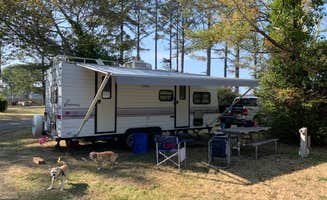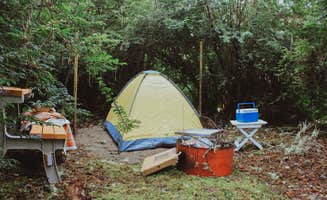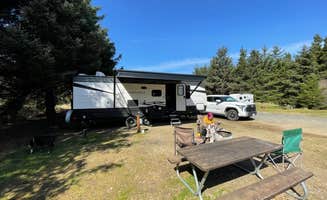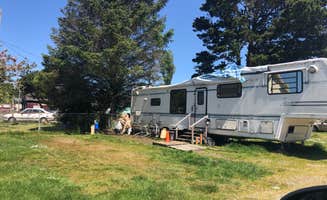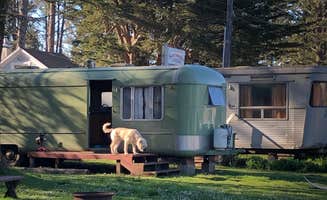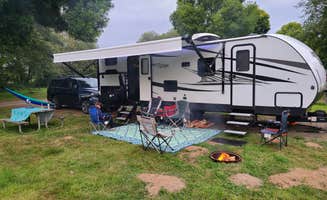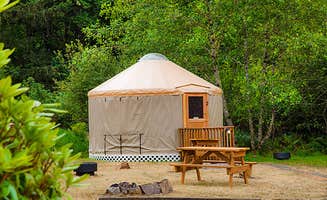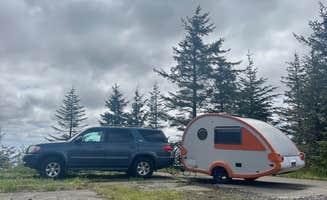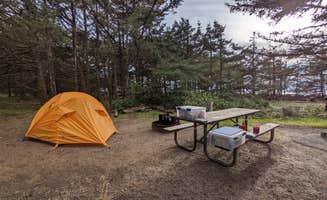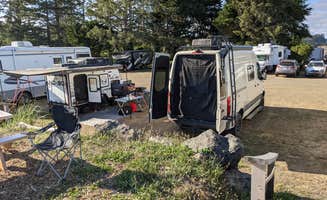Ocean Park camping spots offer a blend of coastal and woodland experiences within the Long Beach Peninsula area. Most sites sit within 2-4 miles of the Pacific Ocean, positioned among coastal forest stands that provide moderate wind protection. Winter temperatures typically range from 35-45°F, while summer averages 60-70°F with frequent morning fog. Campgrounds in the area range from basic tent sites to full-hookup RV parks, with most requiring advance reservations during summer weekends.
What to do
Beach activities year-round: The area beaches near The Lamp Camp provide consistently accessible shores for activities regardless of season. As one visitor noted, "Friendly staff, great facilities and location. Will be coming back!" The beach paths from most campgrounds offer direct access, though some require a short walk through wooded areas.
Historical exploration: Several campgrounds serve as bases for exploring local history, including maritime and military sites. At Fort Stevens State Park, a camper shared, "Oregon is well known for it's magnificent state parks, and this is no exception... with an abundance of hiking trails & historical sites to explore." The park features military installations dating back to the Civil War era.
Seasonal festivals: The Long Beach Peninsula hosts several annual events worth planning around. One camper at Thousand Trails Long Beach mentioned, "The beach hosts kite flying and sand castle building contests. The town is open and friendly." These events primarily occur between May and September, with the International Kite Festival in August drawing particularly large crowds.
What campers like
Private beach access: Many campers value the dedicated beach access points that reduce crowds. A visitor at Cedar to Surf Campground noted, "Short walk to the beautiful ocean. Friendly hosts." Most campgrounds have either direct beach access or require a walk of 0.25-0.5 miles to reach the shore.
Clean shower facilities: Well-maintained bathrooms consistently receive positive mentions in reviews. At Grayland Beach State Park, campers appreciate that "Shower was an acceptable warm temperature" and that the park offers "Good clean rest rooms and free showers." Most state parks in the area provide free hot showers, while private campgrounds may charge $1-2.
Wildlife viewing: The coastal location attracts diverse wildlife throughout the year. One visitor to Road to Snag Lake observed, "Amazing views and complete silence! Tons of rabbits and wildflowers." Many campgrounds post wildlife sighting boards where campers share recent observations of deer, elk, and various shorebirds.
What you should know
Site layout variations: Campground designs vary considerably throughout the region. At Bay Center-Willapa Bay KOA, a camper observed, "The owners did a reasonably good job providing some privacy between sites given that it's a typical field with some trees." State parks typically offer more separation between sites compared to private RV parks.
Reservations essential: During peak periods (June-September), advance planning is crucial. Many campgrounds fill completely during summer weekends, especially those with full hookups. Most state parks open reservations 9 months in advance, while private campgrounds typically accept bookings 6-12 months ahead.
Variable cell coverage: Connectivity fluctuates significantly throughout the area. One visitor to Ocean City State Park reported, "I got zero reception in the campground. I use Verizon." Campgrounds near towns typically offer better coverage, while more remote locations may require driving 5-10 miles for reliable signal.
Tips for camping with families
Enclosed camping options: For families concerned about weather variability, several campgrounds offer alternatives to tent camping. One visitor to Cape Disappointment noted, "Great state park with campsites right on the beach or very near the beach... Yurts and cabins also available." These structures typically cost $45-85 per night and should be reserved months in advance.
Kid-friendly amenities: Some campgrounds specifically cater to children with dedicated recreational facilities. At Astoria-Warrenton-Seaside KOA, families appreciate that it's a "Very busy campground with lots of things to keep you occupied and make the weekend go by way to quick." Many private campgrounds offer scheduled activities during summer months, including nature programs, craft sessions, and outdoor games.
Mosquito preparation: Families should come prepared for seasonal insects, particularly in wooded areas away from direct shore breezes. As one camper at Fort Stevens State Park advised, "Bring mosquito repellent!" Bug activity is typically highest in the evening hours from June through August, especially in areas with standing water.
Tips from RVers
Hookup positioning challenges: RVers frequently mention issues with utility connections at certain campgrounds. At Thousand Trails Long Beach, one camper observed, "The odd numbered spots all have the sewer on the wrong side requiring a very long sewer hose extension that the hardware store nearby does have." RVers should carry extension cords and extra-length water and sewer hoses when camping in this region.
Weather-related driving concerns: Coastal weather affects road conditions throughout the year. Winter and spring travelers should prepare for muddy access roads at some campgrounds. In summer, sand can accumulate on beach access roads, requiring careful driving, particularly for larger rigs.
Dump station availability: Not all campgrounds offer on-site dumping facilities, requiring advance planning. State parks typically maintain dump stations near their entrance gates, while some private campgrounds charge $5-10 for dump station use by non-guests.


